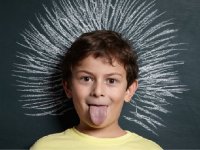Encouraging the Einstein and Edison in Everyone
Teach creativity by emulating great scientific thinkers: make friends with failure, generate ideas, connect the unconnected, and don’t judge answers while creating them.
The 21st century will require solutions that are fashioned differently from how the problems were made. The solutions of this century will come from creative people who are willing to look at doing things differently. As such, the future will need more Albert Einsteins and Thomas Edisons -- and by the way, there is a bit of them in all of us. Here are some ways to nurture both in all of your students.
Harvesting a Bumper Crop of Ideas
When in comes to creativity, there are two schools of thought to consider. One path is to generate lots of ideas and see which fits. This is called divergent thinking. When it comes to divergent thinking, inventor Thomas Edison was a master. Edison had over one thousand patents to his name. He believed in trying lots of ideas to find the one that worked. In fact, this is how he created the light bulb. When looking to make light bulbs last longer, he hunted for thin wires, called filaments, which would glow when heated by the electricity passing through them. Edison tried 9,999 different materials -- including bamboo, hickory, and human hair -- before he finally reached the carbon filament (with some help from Lewis Latimer).
A reporter interviewed Edison after his invention and asked why he didn't feel like a failure for all those thousands of attempts. Edison replied in his famous optimistic style, "I found 9,999 ways how not to make one." His response gives us another clue about the creative process -- he made friends with failure and rebranded those 9,999 unsuccessful attempts as data collection. The key point is that we must exercise our students' muscles for coming up with lots of ideas, or brainstorming, and teach them not to judge their answers in their creation, but later in their evaluation.
1. Encouraging Inner Edisons: Be An Idea Generator
Here is a little activity you might want to try in your classroom to nurture divergent thinking within your students. Bring in an item from home like a key, a cup, a toothbrush, or any other object. Now, have your students come up with a list of possible uses for this item. For example, a key is designed to open doors, but it can also be used to unseal a package, or carve wood, or open a can. But that's not all. A key can also be a computer stylus, an ice scraper, an earring, and part of a wind chime. (You get the point!) See what comes up. No answer is wrong. The goal of the activity is to generate as many ideas as possible.
2. Encouraging Inner Einsteins: Making New Connections
The second type of creativity is the linking of things from different topics. This is the Janusian approach, named after Janus, the Roman god of opposites. Many famous innovators used this type of thinking. Isaac Newton paralleled a falling apple to gravity's pull on the moon. Johannes Kepler connected the mechanism of a clock to the motion of the planets. Even Einstein found a relationship between railroad trains and the motion of light in his special theory of relativity. Geniuses are not afraid to connect the unconnected to better understand. And this is a skill that we can all build to be more creative.
The best way to describe the Janusian approach is the use of analogies as a model to help grasp a concept. Analogies, comparisons, and metaphors are thought-mappings that help our understanding. And when we give children an opportunity to make such mappings, they are better prepared to invent something new. They are getting in touch with their inner Einsteins. They'll be able to make unusual parallels between topics. They'll create. If metaphors are the tools used by geniuses, then the art of using metaphors will benefit all of us, too.
Playing With Connections
Connecting formerly unconnected topics is another muscle that students need to exercise. Here is an activity that aims to build that skill. Make two lists of random objects, and ask your students to find connections between one word from each of the lists. Explore the linkages. They might be very entertaining. And again, there is no wrong answer.
Here is an example:
List 1
- Water
- Ants
- Circle
List 2
- Traffic
- Crayon
- Glass
For instance, students might find that both water and glass give a reflection. For circle and crayon, students might suggest that crayons should be shaped like hockey pucks. For ants and traffic, your pupils may make the connection that they both behave like a swarm. And so on. Make a game out of the activity, and have students share with others their connections. (By the way, researchers have recently found that ants can give us insight into how to prevent traffic jams. See, Janusian thinking works!)
As we prepare children for the 21st century, let’s take a lesson or two from the creative geniuses of the 20th century, particularly Einstein and Edison. By exercising these tools of the trade, we better prepare our children to invent, to create, and to solve problems. So let's be creative in the way that we teach children to be creative.
